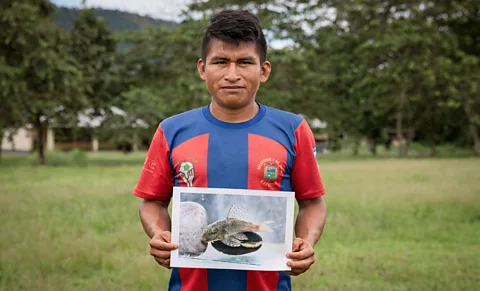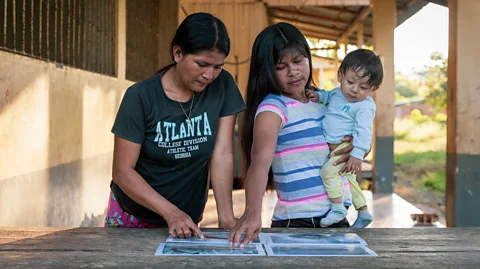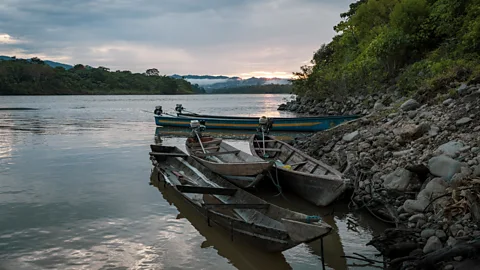‘It’s one of the least known’: A remote and dangerous Amazon river finally spills its secrets

Legend has it that the Santiago river used to swallow the canoe of anyone trying to explore it. Now an indigenous community is discovering surprising species in its waters.
We stepped into the wooden canoe bobbing on the murky water of the Santiago river, ready to visit one of the Amazon region’s least-known ecosystems. Until very recently, scientists didn’t even know which fish inhabited this part of the river, as it had never been studied. Now, after a two-day journey by bus and truck from Quito, Ecuador’s capital, photographer Karen Toro and I were getting close to our destination: Kaputna, an indigenous community that has discovered new fish species here.
Surrounded by virgin jungle, where jaguars, peccaries and pumas still roam, Kaputna is a settlement on the banks of the Santiago river of 145 inhabitants who are members of the Shuar, one of the 11 indigenous nations living in the Ecuadorian Amazon. While Ecuador is considered a hotspot for freshwater fish, scientists warned in 2021 that the lack of data on its fish was “staggering”, and that there was an urgent need for more research.
A group of Kaputna residents has helped fill this gap, discovering a wealth of hidden fish flitting through the river, camouflaged by shades of brown and silver, using specially adapted mouths to feed off its submerged rocks. Thanks to monitoring efforts carried out between 2021 and 2022, combining traditional and scientific knowledge, the indigenous community managed to identify 144 species of fish in the Santiago waters. Five of them are known from other countries, but have never been found in Ecuador before. One species is still being studied and could be a completely new to science, according to biologists participating in the research. Kaputna fishermen such as Germán Narankas are listed as co-authors of the scientific publication that reports these findings.
“Their knowledge of the territory is essential for discovering new species,” Jonathan Valdiviezo, a biologist who provided support during the sample analysis stage, says of the fishermen’s findings. For Fernando Anaguano, main author of the study and the Wildlife Conservation Society (WCS) biologist that accompanied Kaputna during the whole process, the study marks a landmark change in how scientists work with, and acknowledge, local contributors. “This custom of recognising the work of local people is not usually seen in scientific publications,” he says.

A ‘canoe-swallowing’ river
Local legends say that, in the days before motorboats, people who rowed down the lower part of the Santiago River disappeared. A hole “swallowed” the canoes, and strangers never made it to the community. That is where the name Kaputna, or “area where the river is fast-flowing”, comes from, according to locals.
To get there, it took us a 10-hour drive from Quito, the Ecuadorian capital, to Tiwintza, an Amazonian town on the border with Peru, where we stayed overnight. In the morning, Germán Narankas, a Kaputna fisherman, was waiting for us at the Tiwintza bus terminal, waving at us and smiling. He was easy to spot among the crowd because of the fishing net he carried on his back. “Today is going to be hell. It hasn’t rained in three days”, and the heat was going to be atrocious, he warned us, as he rolled down his sleeves to avoid getting sunburned. At 09:00, the temperature was already 95F (35C).
After buying food, gasoline for his canoe’s motor, and water for our stay in Kaputna – which has neither shops, nor roads – we rented a truck and set off on a 40-minute journey to the port of Peñas on the Santiago River. There, Narankas’ tethered canoe waited for us, moving slightly with the river’s strong current. Canoes equipped with gasoline-powered engines, known as peque-peques, are the only means of transportation to reach Kaputna, and the Santiago River is its only connection to other towns.

The murky water prevented us from seeing the bottom of the river, as if it were protecting the life hidden down there. In calmer sections, we relaxed and enjoyed the lush scenery, but in rougher sections the water turned choppy, rocked the canoe and made us uneasily remember the legend of the disappearing boats. Dodging some logs that had fallen into the river, we eventually arrived at the entrance to Kaputna. The settlement itself was well-hidden in the jungle, but children led us to a zinc-roofed communal shelter where we pitched our tents.
“Let’s go sailing on the river before it gets too late,” Narankas suggested as soon as we’d put up the tents. We set off again, this time into the river’s even more remote reaches, where he and his community made the discoveries that changed their lives.
Flowing with the current
Narankas knows the Santiago like the back of his hand. Even before he took part in the scientific monitoring project, he was familiar with the different fish that lived in the river. In 2021, when the project started, he learned to identify the differences between each species and to call them by their scientific names.
As he steered the peque-peque, he recounted that in 2017, he received a sign. For the Shuar people, the river is more than a body of water or a means of access. On its banks, it is customary to perform the Ayahuasca ritual, in which the Ayahuasca plant, also known as yagé, is consumed. The Shuar believe that the resulting visions reveal the future and guide the actions of those who take it.
“I had dreams that I was going to change the system. In the visions, there was a man who travelled to other countries, and that was me, travelling with this project. I didn’t know it at the time,” he told us.
Four years later, in 2021, researchers from the Ecuadorian WCS asked him to be part of the study focused on discovering the biodiversity of the Santiago River. Narankas and other community members collected fish, took photos of them, and uploaded them to a mobile phone app, Ictio, along with key information such as the location of the catch, the fishing gear used and the characteristics of the animal. “There were about three that I had never seen in my life,” he says.

During the trip, the sound of crickets drowned out the noise of the engine. After we glided through the jungle for almost an hour, the water began to clear until it became completely transparent.
“We’ve reached the Yaupi [river],” Narankas announced. The Yaupi is one of the tributaries of the Santiago, where samples were also taken. It’s the locals’ favourite fishing spot because its waters are clearer and free of mining, which has polluted many other rivers in the Amazon region. In the background, the flags of Peru and Ecuador stood out among the vegetation.
Narankas, his sister Mireya, and his son Josué jumped into the water to fish. The fisherman took out his net and threw it with all his strength into the river, then slowly pulled it back in to check the catch: A fish he calls “carachama“, which is about 10cm (3.9in) long. The scientific name for this family of fish is Loricariidae, and this particular species is Chaetostoma trimaculineum, a dark brown fish with some black spots and a round mouth.
“Around here we found a type of fish that [the researchers] said had never been studied. It was very similar to this carachama,” Narankas explained.
That new fish was Peckoltia relictum, a species that was identified as new to Ecuador. It measures approximately 15cm (5.9in) and usually sticks to rocks. Its mouth is like a suction cup, and instead of scales, it has a type of plate – a characteristic that distinguishes carachamas (Loricariidae).

During the survey, Narankas and his collaborators also took some specimens to a room in Kaputna, which served as their small laboratory, where they measured and weighed the animals, removed parts of their tissue with a scalpel, and preserved the samples in formaldehyde. “It was exciting to learn and collect data. I feel a bit like a scientist,” says Liseth Chuim, a fisherwoman who took part in the monitoring.
“We took a piece of their flesh and sewed a label with their name and number on it,” adds Johnson Kajekai, another Kaputna resident who supported the monitoring team. One of the catches the three remember most was a catfish that measured more than a metre. They also remember one “with a yellow belly” and another that shone with a silver colour.
WCS biologist Fernando Anaguano and his colleagues then collected the samples and transported them to laboratories in Quito.

Revealing the mystery
For the biologists, the collaboration unlocked an ecosystem that was long a mystery to outsiders.
“This [Santiago River] basin is one of the least known. There are few studies that detail or reveal the diversity of fish that exist there,” explains Anaguano, who has been studying freshwater fish for more than a decade. He attributes this to its remoteness and the difficulty in the past of reaching this area, and also says that, historically, freshwater fish have been relatively neglected by scientists. Scientists usually focus on more charismatic animal groups such as mammals or birds, he says, and when studying fish, tend to concentrate on marine species. However, he points out that freshwater fish play an important role in aquatic ecosystems and are a source of food and economic resources for indigenous communities.
Until now, previous research had recorded 143 species in the sprawling area that includes the Santiago River as well as its tributaries less than 600m (1,970ft) above sea level. Known as “Morona Santiago ichthyographic zone”, that area covers more than 6,691 sq km (2,600 sq miles). By comparison, the study with the Kaputna community identified 144 species in an area of only 21.2 sq km (8.2 sq miles) within that zone. Of these, 77 species were recorded that were not reported by the previous research for the Morona Santiago area.
As global leaders gather in the Brazilian Amazon city of Belém for COP, the UN Climate Change Conference, we are running a special series exploring this iconic region’s mysteries across different countries.
The diversity of fish found in the study represents 17% of the total freshwater fish species reported for Ecuador (836) and 20% of those recorded for the Ecuadorian Amazon (725 species). This is a significant percentage considering that the study area in which all these species were found is relatively small, Anaguano says.
In fact, the diversity of fish throughout the Amazon region is enormous. Its basin, located in Ecuador, Peru, Colombia, Bolivia, Brazil, Venezuela, Guyana and Suriname, has the greatest variety of freshwater fish species in the world. So far, 2,500 have been recorded, and it is estimated that there are still thousands to be discovered. These rivers are also home to the longest migration in the planet. The dorado catfish (Brachyplatystoma rousseauxii) travels almost 11,000km (6,800 miles) round trip between the foothills of the Andes and the Amazon estuary, already in the Atlantic Ocean.
We want to conserve fish and also, ensure that fishing is sustainable in the long term – Jonathan Valdiviezo
However, freshwater fish, such as those in the Amazon, are seriously threatened. According to the Living Planet Index (LPI) report on freshwater migratory fish, their populations have declined by 81% in the last 50 years and in Latin America alone, they have declined by 91%. Anaguano explains that, beyond the contribution of fish to keep the balance of life on the planet, these animals are part of the culture and worldview of indigenous peoples.
Food security is another issue. “Fish are the source of protein for local communities. That is why, through this type of research that includes fishermen views, we seek not only to conserve fish but also to ensure that fishing is sustainable in the long term,” adds Jonathan Valdiviezo, a biologist at the National Institute of Biodiversity (Inabio), where the samples from the study were processed and stored.
For Valdiviezo, who has more than 17 years of experience working with fish, one of the crucial points in the process was the training that the Kaputna fishermen received to correctly label the samples. “That helped us avoid problems when recording the species and prevented confusion,” he says.

Still, the journey of discovery featured a number of twists and surprises. During tissue analysis, which included DNA analysis, the researchers found that one of the fish they thought was new to science had actually already been described in 2011. “When we realised that this species was very rare, we extracted DNA from a small piece of muscle,” he says. Then they compared the results of this analysis with the tissue of other related species that are registered in their database. “It’s similar to the process used to determine paternity,” says the biologist. Given the doubts, they sent a sample to Canada, where they confirmed that it was a specimen of Peckoltia relictum, which was known. However, it was a new species for Ecuador, as were four others found in this research.
Both researchers believe that there are still a huge number of species to be discovered in the murky waters of the Santiago. For now, says Valdiviezo, they are still analysing one of the catfish found, as it is believed to be a new species for science. Its main characteristic is that it has black stripes all over its body. Anaguano says that a second paper co-authored by the Kaputna fishermen is expected to be published this year.
Sitting in Kaputna in the evening, under a starry sky, we asked Narankas what seeing his name in the published paper means to him. His eyes welled up. “I feel proud,” he said, smiling. But the impact went even deeper than that. After this experience, the 34-year-old returned to high school in August 2025. In a year and a half, he hopes to graduate and then study biology to continue unlocking the secrets of Santiago River, where its story of scientific discovery is just beginning.










